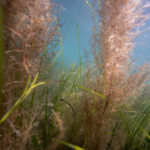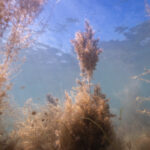Snorkelling in the Isle of Wight
This past weekend, I went freediving in the UK for the first time in my life. One of my beloved friends, Esprit Freediver, organized a safari in collaboration with the very passionate and talented marine biologist Theo Vickers, in the beautiful Isle of Wight.
My a priori before the safari:
As I spent almost all my freediving career diving in the crystal-clear waters of Greece and Tenerife, in the Canary Island, I initially had some apprehensions about the quality of diving in the UK. Here are my initial thoughts:
- Visibility: I was concerned there would be poor visibility, making underwater photography challenging.
- Depth: I assumed there wouldn’t be sufficient depth and that diving in waters less than 5 meters/ 15 feet would be boring.
- Wildlife: I doubted I would encounter much wildlife in such shallow waters compared to the vibrant marine life I was used to.
But what about the reality ?
To be honest, the visibility in the UK waters isn’t amazing, around 5 meters (15 feet), and close to the shore, it is very shallow, ranging from 1 to 5 meters. However, despite these conditions, I had a fantastic experience. The shallow waters make it easier to spot marine life despite the limited visibility, which also gives the underwater environment a unique, misty atmosphere.
Regarding wildlife, patience is key. By following the clues left by the animals, as explained by our guide, you can have some amazing encounters.
During my time there, I had the opportunity to dive at two spots: Seaview during the safari and at Freshwater Bay with my friend Esprit Freediver.
Concerning the wildlife, you need to be patient and follow the clue let by the animals as explained us our guide. But you can make great encounter there.
During my time there I had the chance to dive at two spots, Seaview during the safari and at freshwater bay with my friend Esprit Freediver.
Let me share with you some photos.
Safari at Seaview:
Seagrass and alga
As you can see, this area is mainly covered by eelgrass (Zostera marina) and the invasive species wireweed (Sargassum muticum), which originates from the waters of Japan and South Korea. The wireweed was introduced with oyster spat (an oyster larva that permanently attaches to a substrate) for commercial purposes.
These two species offer shelter, nutrients, and nursery grounds for the diverse fauna living there. For this reason, seagrass is a key species that many others depend on.
These 2 species offers shelter, nutrients and nursery for the different fauna living there. For that reason and especially seagrass are key species where many other depends on it.
Flying over this meadow is beautiful and very distracting. However, you need to stay focused if you want to spot the various inhabitants and the clues they leave behind. It’s like playing hide and seek!
Let’s discover some of them.
Marine life
Obviously, I will show you just a very small portion of what can be encountered here. As many of us were attending the safari, many animals were hiding from us. Discretion and patience are key to observing wild animals.
Our first interesting find was cuttlefish eggs. There were plenty of them, and who would have known they look like this!
As you can see, the eggs look like black raisin grapes attached to the seagrass or algae. A female will lay between 100-1000 eggs, which she will dye with black ink to camouflage them from predators. After 1 or 2 months, the eggs will hatch.
If you don’t know what a cuttlefish looks like, here is a photo I took during an exploration dive in Tenerife.
On an another article I will explain to you how to succeed your approach with cephalopods (including cuttlefish and octopus).
Thornback ray
After that, we encountered many small crustaceans, scallops, and hermit crabs. It’s very difficult to spot them in the middle of this jungle! If you are very lucky and attentive, you can even encounter seahorses and nudibranchs. For that, you really need to move extremely slowly. But our greatest encounter was this beautiful thornback ray (Raja clavata) resting over the sand, preparing for her next hunt at night.
Our guide indicated that this specimen was a female. To identify the gender of rays, you need to look where the tails starts. If it’s a male, you will spot two elongated appendages called claspers, used during reproduction to transfer sperm to the female. Females do not possess these.

We were at the right time to encounter the thornback rays. During the winter (October to April), they tend to live in deeper waters, but they return to shallower, warmer waters during the summer (May to September) to breed and lay their eggs. This environment provides better conditions for the baby rays to survive, offering more food and shelter.
As nocturnal animals, thornback rays hunt mainly crustaceans hidden under the sand, including shrimps and crabs. They use electroreceptive organs called Ampullae of Lorenzini to spot their prey.

As you can see, thornback rays are extremely difficult to spot due to their very efficient camouflage. When they are lying still on the sand, you can only distinguish their shape and eyes if you focus closely. The animal is so confident in its camouflage that even when surrounded by nine intrepid snorkelers, it preferred to stay still, believing it was unseen.
The end
After this great encounter, it was already time to come back on land. We spent 2 hours in the water, and time flew by very quickly. I wanted more!
We had a great day and met amazing people during this safari. Thank you again, Esprit Freediver, for organising this event.
Next time, I will talk about my other dive in the Isle of Wight at Freshwater Bay.
Visit the rest of my website
I am Sébastien Saintignan, underwater photographer, freediving instructor and oceanographer. You can view some of my work with clients or explore my services by clicking the buttons below.
Sources:
Learn more about cuttlefish:
Learn more about rays:

























